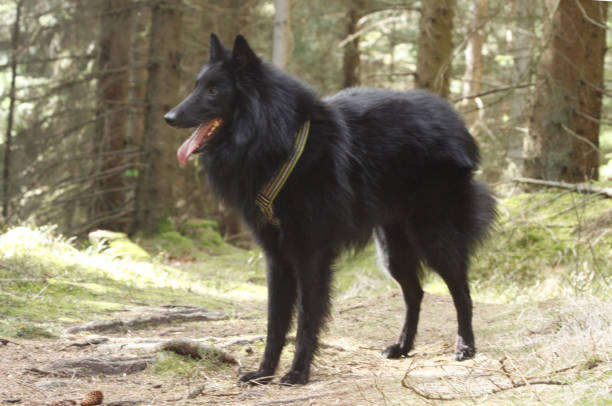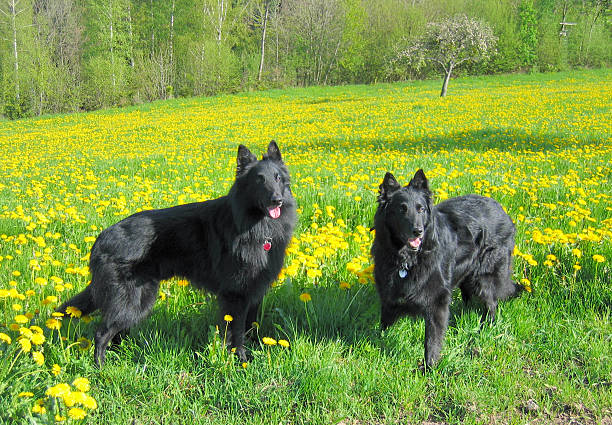Belgian Groenendael

Breed History:
The Belgian Groenendael is one of the four varieties of Belgian Shepherds, developed in Belgium in the late 1800s as a herding and guard dog. Named after the village of Groenendael, where it was first standardised by breeder Nicolas Rose, this variety is known for its striking black coat and versatility in work. All four Belgian Shepherd varieties—Groenendael, Malinois, Laekenois, and Tervuren—share the same breed standard except for coat type and colour.
The Groenendael gained international recognition as a working dog and excelled in police and military roles, especially during World Wars I and II. Its intelligence, loyalty, and trainability have made it a favourite not only for herding and guarding but also for roles in detection, search-and-rescue, and service work. Today, the Groenendael remains popular as a companion and working breed across Europe and North America.
Considering adopting a Belgian Groenendael or a similar shepherd breed? Check out our page "How to look after a German Shepherd" detailing what to consider before adopting and our recommended products for a German Shepherd and other shepherd breeds.
|
Gender |
Height |
Weight |
|
Male |
60–66 cm |
25–30 kg |
|
Female |
56–62 cm |
20–25 kg |
Size – Medium-Large
Life Expectancy: 12–14 years

Breed Appearance:
The Belgian Groenendael is an elegant, well-proportioned dog with a proud carriage and a long, dense black coat that gives it a noble appearance. Its double coat features a thick undercoat and a straight, slightly harsh outer coat that forms a mane around the neck and feathering on the legs and tail.
It has a chiselled head, dark almond-shaped eyes, and erect triangular ears that give it a highly alert expression. The Groenendael moves with fluid grace and is built for both endurance and agility. Its striking black coat and intelligent demeanour make it stand out among other working breeds.
Breed Type – Family/Guard:
Originally bred as a herding dog, the Belgian Groenendael is a natural guardian, making it well-suited for both family protection and companionship. It is deeply loyal, forming strong bonds with its family, and is especially affectionate with those it knows and trusts.
This breed is vigilant and wary of strangers, which makes it an effective watchdog. However, it is not aggressive without reason and is generally well-mannered when properly socialised. The Groenendael thrives in environments where it can have a job or purpose, whether herding, guarding, or engaging in dog sports.

Training:
Highly intelligent and eager to work, the Belgian Groenendael is a dream to train for experienced handlers. It learns quickly and enjoys mental challenges, making it ideal for obedience, agility, tracking, and protection training. However, its intelligence also means it can become bored or mischievous if under-stimulated.
Training should be firm but fair, using positive reinforcement techniques. This breed is sensitive and responds best to consistency, praise, and varied activities. Early socialisation is essential to help the Groenendael develop confidence and good manners, especially around other dogs and new environments.
Health & Care:
The Belgian Groenendael is generally a robust and healthy breed with a good lifespan. Some genetic concerns include hip and elbow dysplasia, epilepsy, and progressive retinal atrophy (PRA). Reputable breeders test for these conditions to ensure the health of their lines.
Its thick double coat requires regular grooming to prevent matting, especially during seasonal shedding. Routine veterinary care, vaccinations, and a balanced diet are key to maintaining long-term health. Like all working breeds, the Groenendael benefits from regular physical and mental stimulation.

Living Conditions:
While adaptable to various living environments, the Belgian Groenendael is best suited to homes with space to roam or an active lifestyle. It can live in apartments if given sufficient daily exercise and mental enrichment, but it thrives in homes with a yard or access to the outdoors.
This breed is not ideal for sedentary households. It craves interaction, activity, and purpose. Without regular engagement, it may develop behavioural problems such as barking, chewing, or pacing. The Groenendael prefers cool climates due to its dense coat and does best in environments where it can stay busy and close to its people.
Exercise:
The Belgian Groenendael is an energetic breed that requires substantial daily exercise—ideally 1 to 2 hours of activity that includes both physical exertion and mental challenges. Walks alone aren’t enough; it thrives on tasks such as herding games, advanced obedience, agility, or protection work.
Interactive play, puzzle toys, and structured training sessions help satisfy the Groenendael’s sharp mind. Regular off-leash play in a safe, enclosed area allows it to burn off energy and stay fit. Without adequate exercise, it may become restless, vocal, or destructive.
Grooming:
The Groenendael’s luxurious black coat needs consistent grooming to stay healthy and tangle-free. Weekly brushing is usually sufficient, though more frequent grooming is necessary during shedding seasons (spring and fall), when the undercoat is heavily shed.
Bathing is needed only occasionally, as the breed’s coat is relatively clean and odourless. Regular nail trimming, ear cleaning, and dental care are essential to maintain overall hygiene. Inspect for ticks or debris after time outdoors, especially around the feathered areas of the coat.

Advantages:
-
Intelligent and highly trainable; excels in many canine sports
-
Deeply loyal and affectionate with its family
-
Naturally protective and an effective watchdog
-
Elegant and striking appearance with a noble bearing
-
Versatile working dog with a strong desire to please
-
Adapts well to active homes and thrives with structure
Disadvantages:
-
Needs extensive daily exercise and mental stimulation
-
Can become anxious or destructive if bored or under-stimulated
-
Strong guarding instincts require early and consistent socialisation
-
Not ideal for first-time or sedentary dog owners
-
A dense coat requires regular grooming and sheds heavily twice a year
-
May be reserved or aloof with strangers without proper socialisation

